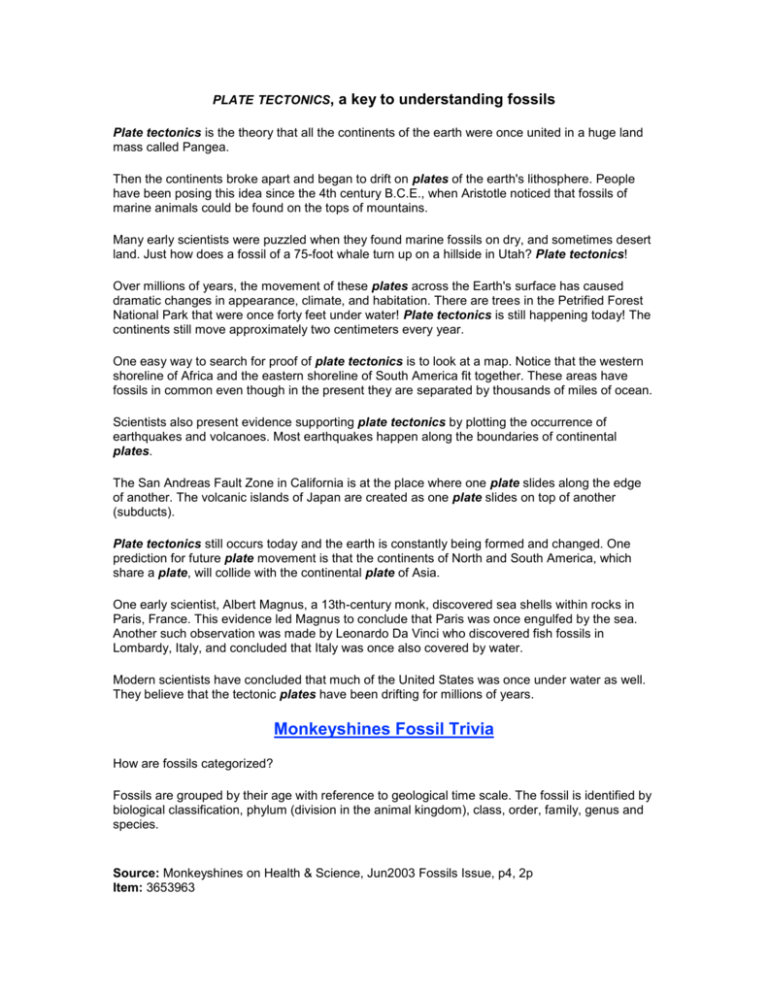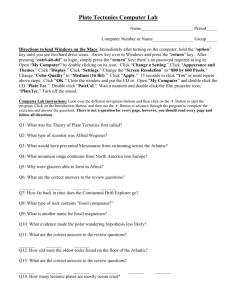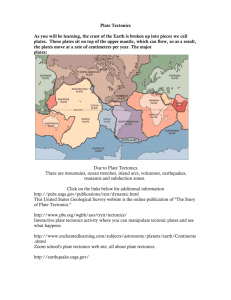PLATE TECTONICS
advertisement

PLATE TECTONICS, a key to understanding fossils Plate tectonics is the theory that all the continents of the earth were once united in a huge land mass called Pangea. Then the continents broke apart and began to drift on plates of the earth's lithosphere. People have been posing this idea since the 4th century B.C.E., when Aristotle noticed that fossils of marine animals could be found on the tops of mountains. Many early scientists were puzzled when they found marine fossils on dry, and sometimes desert land. Just how does a fossil of a 75-foot whale turn up on a hillside in Utah? Plate tectonics! Over millions of years, the movement of these plates across the Earth's surface has caused dramatic changes in appearance, climate, and habitation. There are trees in the Petrified Forest National Park that were once forty feet under water! Plate tectonics is still happening today! The continents still move approximately two centimeters every year. One easy way to search for proof of plate tectonics is to look at a map. Notice that the western shoreline of Africa and the eastern shoreline of South America fit together. These areas have fossils in common even though in the present they are separated by thousands of miles of ocean. Scientists also present evidence supporting plate tectonics by plotting the occurrence of earthquakes and volcanoes. Most earthquakes happen along the boundaries of continental plates. The San Andreas Fault Zone in California is at the place where one plate slides along the edge of another. The volcanic islands of Japan are created as one plate slides on top of another (subducts). Plate tectonics still occurs today and the earth is constantly being formed and changed. One prediction for future plate movement is that the continents of North and South America, which share a plate, will collide with the continental plate of Asia. One early scientist, Albert Magnus, a 13th-century monk, discovered sea shells within rocks in Paris, France. This evidence led Magnus to conclude that Paris was once engulfed by the sea. Another such observation was made by Leonardo Da Vinci who discovered fish fossils in Lombardy, Italy, and concluded that Italy was once also covered by water. Modern scientists have concluded that much of the United States was once under water as well. They believe that the tectonic plates have been drifting for millions of years. Monkeyshines Fossil Trivia How are fossils categorized? Fossils are grouped by their age with reference to geological time scale. The fossil is identified by biological classification, phylum (division in the animal kingdom), class, order, family, genus and species. Source: Monkeyshines on Health & Science, Jun2003 Fossils Issue, p4, 2p Item: 3653963








